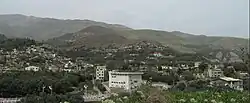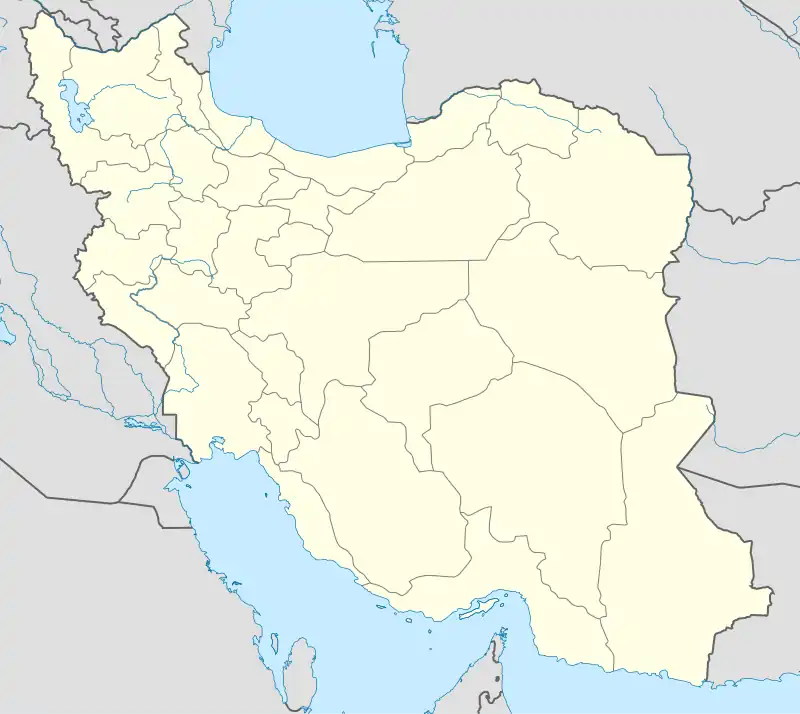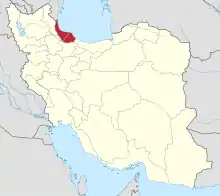Rudbar
Persian: رودبار | |
|---|---|
City | |
 | |
 Rudbar | |
| Coordinates: 36°49′15″N 49°25′36″E / 36.82083°N 49.42667°E[1] | |
| Country | Iran |
| Province | Gilan |
| County | Rudbar |
| District | Central |
| Population (2016)[2] | |
| • Total | 10,504 |
| Time zone | UTC+3:30 (IRST) |
| Area code | +98(013) |
Rudbar (Persian: رودبار, romanized: Rudbār) (Gilaki:, rubâr)[3] is a city in the Central District of Rudbar County, Gilan province, Iran, serving as both capital of the district and of the county.[4]
At the 2006 National Census, its population was 11,454 in 3,303 households.[5] The following census in 2011 counted 10,926 people in 3,406 households.[6] The latest census in 2016 showed a population of 10,504 people in 3,559 households.[2]
Rudbar is 268 kilometres (167 mi) from Tehran and with a variable climate. It is located on the fringes of a valley through which the Sepid River (Sepidrood in Farsi, Esparoo in Roudbari language) flows. Rudbar can be considered as a gateway to the Gīlān Province from central Iran.
Its name (meaning "by the river" in Persian) is a reference to the river named Sepid Rood (Sepid Roud) that passes by the city. Rudbar is also called "Roodbar Zeitoun (olive)" for the olive gardens in the area.
Rudbar's local economy notably includes olives and olive-based products. Groves of olive trees surround the city. Olive oil is produced locally. Rudbar is also known for its cream-hued, handcrafted carpets of fine quality. Despite the olive gardens that may suggest presence of a Mediterranean climate, the winters are very cold in the area. The winds in the Sepid Rood valley (Manjil) are well known in the country.
Main language there is the Roudbari Language, a subdivision of Mard indigenous language. There are several dialects and ethnicities in Gilan who have either their own language from South Caspies or slight variations to the way they speak. Some of these "sub-dialects" of Gilaki are Rashti, Some’e Sarai, Eastern Gilaki (Lahijan, Langerud, Rudesar, Amlash, chaboksar). The majority of the people in Rudbar are Mards, and a minority are Talysh. They speak the Talysh Language with Galeshi Dialect and the Gilaki Language with Rudbari Sub-dialect.[7][8]
History
The civilization of Rudbar and its surroundings date back to about 3000 years BCE. The Marlik bowl, a famous archeological artifact and one of the oldest gold bowls in the world from 1st millennium BC, was found there. With the advent of Islam, tribes from Damascus and Halab (Aleppo) immigrated and became settlers there. Later, Nizari Isma'ili da'i made inroads and eventually established an Assassin stronghold. In the era of Nader Shah Afshar, groups from the Kurds of Quchan and areas of northern Khorassan also settled there.
Rudbar was near the epicenter of the 1990 Manjil–Rudbar earthquake of magnitude 7.3 on the Richter scale (MS=7.7, MW=7.3, mb=6.4) at 12:31am local time on June 21, 1990, that killed around 50,000 and injured 100,000 city residents.[9] Despite reconstruction, it has not regained its former glory.
References
- ↑ OpenStreetMap contributors (7 October 2023). "Rudbar, Rudbar County" (Map). OpenStreetMap. Retrieved 7 October 2023.
- 1 2 "Census of the Islamic Republic of Iran, 1395 (2016)". AMAR (in Persian). The Statistical Center of Iran. p. 01. Archived from the original (Excel) on 4 December 2020. Retrieved 19 December 2022.
- ↑ Rudbar can be found at GEOnet Names Server, at this link, by opening the Advanced Search box, entering "-3081436" in the "Unique Feature Id" form, and clicking on "Search Database".
- ↑ Habibi, Hassan (21 June 1369). "Approval of the organization and chain of citizenship of the elements and units of the national divisions of Gilan province centered on the city of Rasht". Islamic Parliament Research Center (in Persian). Ministry of Interior, Defense Political Commission of the Government Board. Archived from the original on 12 October 2016. Retrieved 12 December 2023.
- ↑ "Census of the Islamic Republic of Iran, 1385 (2006)". AMAR (in Persian). The Statistical Center of Iran. p. 01. Archived from the original (Excel) on 20 September 2011. Retrieved 25 September 2022.
- ↑ "Census of the Islamic Republic of Iran, 1390 (2011)". Syracuse University (in Persian). The Statistical Center of Iran. p. 01. Archived from the original (Excel) on 8 October 2023. Retrieved 19 December 2022.
- ↑ "Gilaki".
- ↑ Guyeš-e Tāti-y-e Rudbār (The Tati Dialect of Rudbar), Jahandoost Sabzalipour, Rasht: Farhang-e Iliya Press, 2011
- ↑ ReliefWeb Report of Earthquake, ReliefWeb, June 1990
- Book of Amarlu - M.M.Zand
